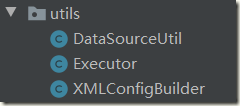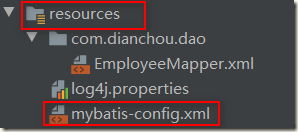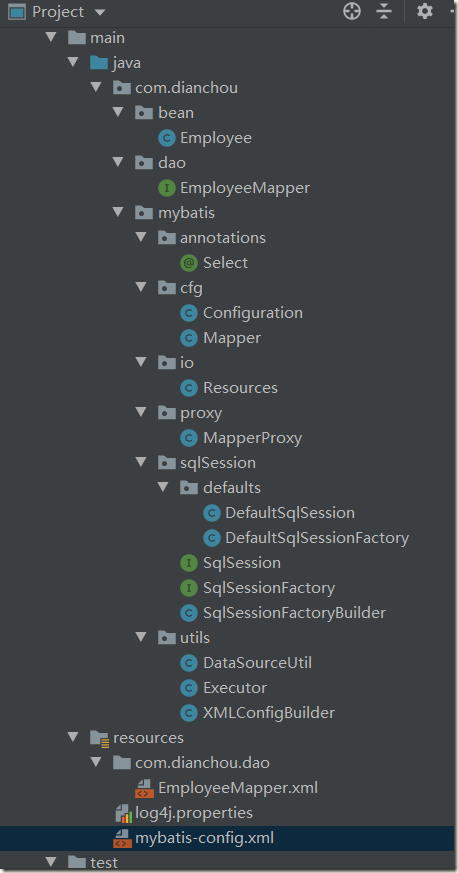Mybatis学习(二)-简单自定义mybatis框架
一、分析流程
二、代码编写
2.1、创建maven工程
引入相关依赖:不需要引入mybatis

<dependencies> <dependency> <groupId>mysql</groupId> <artifactId>mysql-connector-java</artifactId> <version>5.1.46</version> </dependency> <dependency> <groupId>log4j</groupId> <artifactId>log4j</artifactId> <version>1.2.12</version> </dependency> <dependency> <groupId>junit</groupId> <artifactId>junit</artifactId> <version>4.10</version> <scope>test</scope> </dependency> <!-- 解析 xml 的 dom4j --> <dependency> <groupId>dom4j</groupId> <artifactId>dom4j</artifactId> <version>1.6.1</version> </dependency> <!-- dom4j 的依赖包 jaxen --> <dependency> <groupId>jaxen</groupId> <artifactId>jaxen</artifactId> <version>1.1.6</version> </dependency> </dependencies>
2.2、引入工具类到项目中
1)解析XML配置文件

/** * 用于解析配置文件 */ public class XMLConfigBuilder { /** * 解析主配置文件,把里面的内容填充到DefaultSqlSession所需要的地方 * 使用的技术: * dom4j+xpath */ public static Configuration loadConfiguration(InputStream config){ try{ //定义封装连接信息的配置对象(mybatis的配置对象) Configuration cfg = new Configuration(); //1.获取SAXReader对象 SAXReader reader = new SAXReader(); //2.根据字节输入流获取Document对象 Document document = reader.read(config); //3.获取根节点 Element root = document.getRootElement(); //4.使用xpath中选择指定节点的方式,获取所有property节点 List<Element> propertyElements = root.selectNodes("//property"); //5.遍历节点 for(Element propertyElement : propertyElements){ //判断节点是连接数据库的哪部分信息 //取出name属性的值 String name = propertyElement.attributeValue("name"); if("driver".equals(name)){ //表示驱动 //获取property标签value属性的值 String driver = propertyElement.attributeValue("value"); cfg.setDriver(driver); } if("url".equals(name)){ //表示连接字符串 //获取property标签value属性的值 String url = propertyElement.attributeValue("value"); cfg.setUrl(url); } if("username".equals(name)){ //表示用户名 //获取property标签value属性的值 String username = propertyElement.attributeValue("value"); cfg.setUsername(username); } if("password".equals(name)){ //表示密码 //获取property标签value属性的值 String password = propertyElement.attributeValue("value"); cfg.setPassword(password); } } //取出mappers中的所有mapper标签,判断他们使用了resource还是class属性 List<Element> mapperElements = root.selectNodes("//mappers/mapper"); //遍历集合 for(Element mapperElement : mapperElements){ //判断mapperElement使用的是哪个属性 Attribute attribute = mapperElement.attribute("resource"); if(attribute != null){ System.out.println("使用的是XML"); //表示有resource属性,用的是XML //取出属性的值 String mapperPath = attribute.getValue();//获取属性的值"com/itheima/dao/IUserDao.xml" //把映射配置文件的内容获取出来,封装成一个map Map<String,Mapper> mappers = loadMapperConfiguration(mapperPath); //给configuration中的mappers赋值 cfg.setMappers(mappers); }else{ System.out.println("使用的是注解"); //表示没有resource属性,用的是注解 //获取class属性的值 String daoClassPath = mapperElement.attributeValue("class"); //根据daoClassPath获取封装的必要信息 Map<String,Mapper> mappers = loadMapperAnnotation(daoClassPath); //给configuration中的mappers赋值 cfg.setMappers(mappers); } } //返回Configuration return cfg; }catch(Exception e){ throw new RuntimeException(e); }finally{ try { config.close(); }catch(Exception e){ e.printStackTrace(); } } } /** * 根据传入的参数,解析XML,并且封装到Map中 * @param mapperPath 映射配置文件的位置 * @return map中包含了获取的唯一标识(key是由dao的全限定类名和方法名组成) * 以及执行所需的必要信息(value是一个Mapper对象,里面存放的是执行的SQL语句和要封装的实体类全限定类名) */ private static Map<String, Mapper> loadMapperConfiguration(String mapperPath)throws IOException { InputStream in = null; try{ //定义返回值对象 Map<String,Mapper> mappers = new HashMap<String,Mapper>(); //1.根据路径获取字节输入流 in = Resources.getResourceAsStream(mapperPath); //2.根据字节输入流获取Document对象 SAXReader reader = new SAXReader(); Document document = reader.read(in); //3.获取根节点 Element root = document.getRootElement(); //4.获取根节点的namespace属性取值 String namespace = root.attributeValue("namespace");//是组成map中key的部分 //5.获取所有的select节点 List<Element> selectElements = root.selectNodes("//select"); //6.遍历select节点集合 for(Element selectElement : selectElements){ //取出id属性的值 组成map中key的部分 String id = selectElement.attributeValue("id"); //取出resultType属性的值 组成map中value的部分 String resultType = selectElement.attributeValue("resultType"); //取出文本内容 组成map中value的部分 String queryString = selectElement.getText(); //创建Key String key = namespace+"."+id; //创建Value Mapper mapper = new Mapper(); mapper.setQueryString(queryString); mapper.setResultType(resultType); //把key和value存入mappers中 mappers.put(key,mapper); } return mappers; }catch(Exception e){ throw new RuntimeException(e); }finally{ in.close(); } } /** * 根据传入的参数,得到dao中所有被select注解标注的方法。 * 根据方法名称和类名,以及方法上注解value属性的值,组成Mapper的必要信息 * @param daoClassPath * @return */ private static Map<String,Mapper> loadMapperAnnotation(String daoClassPath)throws Exception{ //定义返回值对象 Map<String,Mapper> mappers = new HashMap<String, Mapper>(); //1.得到dao接口的字节码对象 Class daoClass = Class.forName(daoClassPath); //2.得到dao接口中的方法数组 Method[] methods = daoClass.getMethods(); //3.遍历Method数组 for(Method method : methods){ //取出每一个方法,判断是否有select注解 boolean isAnnotated = method.isAnnotationPresent(Select.class); if(isAnnotated){ //创建Mapper对象 Mapper mapper = new Mapper(); //取出注解的value属性值 Select selectAnno = method.getAnnotation(Select.class); String queryString = selectAnno.value(); mapper.setQueryString(queryString); //获取当前方法的返回值,还要求必须带有泛型信息 Type type = method.getGenericReturnType();//List<User> //判断type是不是参数化的类型 if(type instanceof ParameterizedType){ //强转 ParameterizedType ptype = (ParameterizedType)type; //得到参数化类型中的实际类型参数 Type[] types = ptype.getActualTypeArguments(); //取出第一个 Class domainClass = (Class)types[0]; //获取domainClass的类名 String resultType = domainClass.getName(); //给Mapper赋值 mapper.setResultType(resultType); } //组装key的信息 //获取方法的名称 String methodName = method.getName(); String className = method.getDeclaringClass().getName(); String key = className+"."+methodName; //给map赋值 mappers.put(key,mapper); } } return mappers; } }
2)执行SQL语句,并且封装结果集

/** * 负责执行SQL语句,并且封装结果集 */ public class Executor { public <E> List<E> selectList(Mapper mapper, Connection conn) { PreparedStatement pstm = null; ResultSet rs = null; try { //1.取出mapper中的数据 String queryString = mapper.getQueryString();//select * from user String resultType = mapper.getResultType();//com.itheima.domain.User Class domainClass = Class.forName(resultType); //2.获取PreparedStatement对象 pstm = conn.prepareStatement(queryString); //3.执行SQL语句,获取结果集 rs = pstm.executeQuery(); //4.封装结果集 List<E> list = new ArrayList<E>();//定义返回值 while(rs.next()) { //实例化要封装的实体类对象 E obj = (E)domainClass.newInstance(); //取出结果集的元信息:ResultSetMetaData ResultSetMetaData rsmd = rs.getMetaData(); //取出总列数 int columnCount = rsmd.getColumnCount(); //遍历总列数 for (int i = 1; i <= columnCount; i++) { //获取每列的名称,列名的序号是从1开始的 String columnName = rsmd.getColumnName(i); //根据得到列名,获取每列的值 Object columnValue = rs.getObject(columnName); //给obj赋值:使用Java内省机制(借助PropertyDescriptor实现属性的封装) PropertyDescriptor pd = new PropertyDescriptor(columnName,domainClass);//要求:实体类的属性和数据库表的列名保持一种 //获取它的写入方法 Method writeMethod = pd.getWriteMethod(); //把获取的列的值,给对象赋值 writeMethod.invoke(obj,columnValue); } //把赋好值的对象加入到集合中 list.add(obj); } return list; } catch (Exception e) { throw new RuntimeException(e); } finally { release(pstm,rs); } } private void release(PreparedStatement pstm,ResultSet rs){ if(rs != null){ try { rs.close(); }catch(Exception e){ e.printStackTrace(); } } if(pstm != null){ try { pstm.close(); }catch(Exception e){ e.printStackTrace(); } } } }
3)获取数据库连接

/** * 获取数据库连接 */ public class DataSourceUtil { public static Connection getConnection(Configuration cfg){ try { Class.forName(cfg.getDriver()); return DriverManager.getConnection(cfg.getUrl(),cfg.getUsername(),cfg.getPassword()); } catch (Exception e) { throw new RuntimeException(e); } } }
2.3、编写mybatis-config.xml

<?xml version="1.0" encoding="UTF-8" ?> <configuration> <!-- 配置 mybatis 的环境 --> <environments default="development"> <!-- 配置 mysql 的环境 --> <environment id="development"> <!-- 配置事务的类型 --> <transactionManager type="JDBC"/> <!-- 配置连接数据库的信息:用的是数据源(连接池) --> <dataSource type="POOLED"> <property name="driver" value="com.mysql.jdbc.Driver"/> <property name="url" value="jdbc:mysql://localhost:3306/mybatis?useSSL=true&useUnicode=true&characterEncoding=utf8"/> <property name="username" value="root"/> <property name="password" value="123456"/> </dataSource> </environment> </environments> <!--sql映射文件一定要注册到全局配置文件中--> <mappers> <mapper resource="com/dianchou/dao/EmployeeMapper.xml"></mapper> <!--<mapper class="com.dianchou.dao.EmployeeMapper"></mapper>--> </mappers> </configuration>
注意:
此处我们直接使用的是 mybatis 的配置文件,但是由于我们没有使用 mybatis 的 jar 包,所以要把配 置文件的约束删掉否则会报错(如果电脑能接入互联网,不删也行)
2.4、编写读取配置文件类 Resources

package com.dianchou.mybatis.io; import java.io.InputStream; //使用类加载器读取配置文件的类 public class Resources { //根据传入的参数获取一个字节输入流 public static InputStream getResourceAsStream(String filePath){ return Resources.class.getClassLoader().getResourceAsStream(filePath); } }
2.5、编写 Mapper 类

package com.dianchou.mybatis.cfg; public class Mapper { private String queryString; //SQL private String resultType; //实体类的全限定类名 public String getQueryString() { return queryString; } public void setQueryString(String queryString) { this.queryString = queryString; } public String getResultType() { return resultType; } public void setResultType(String resultType) { this.resultType = resultType; } }
2.6、编写 Configuration 配置类

package com.dianchou.mybatis.cfg; import java.util.HashMap; import java.util.Map; //自定义mybatis的配置类 public class Configuration { private String driver; private String url; private String username; private String password; private Map<String,Mapper> mappers = new HashMap<String, Mapper>(); public Map<String, Mapper> getMappers() { return mappers; } public void setMappers(Map<String, Mapper> mappers) { this.mappers.putAll(mappers);//自出需要使用追加的方法 } public String getDriver() { return driver; } public void setDriver(String driver) { this.driver = driver; } public String getUrl() { return url; } public void setUrl(String url) { this.url = url; } public String getUsername() { return username; } public void setUsername(String username) { this.username = username; } public String getPassword() { return password; } public void setPassword(String password) { this.password = password; } }
2.7、编写实体类

package com.dianchou.bean; public class Employee { private Integer id; private String lastName; private String email; private String gender; public Employee() { } public Employee(Integer id, String lastName, String email, String gender) { this.id = id; this.lastName = lastName; this.email = email; this.gender = gender; } public Integer getId() { return id; } public void setId(Integer id) { this.id = id; } public String getLastName() { return lastName; } public void setLastName(String lastName) { this.lastName = lastName; } public String getEmail() { return email; } public void setEmail(String email) { this.email = email; } public String getGender() { return gender; } public void setGender(String gender) { this.gender = gender; } @Override public String toString() { return "Employee{" + "id=" + id + ", lastName='" + lastName + '\'' + ", email='" + email + '\'' + ", gender='" + gender + '\'' + '}'; } }
2.8、基于 XML 的自定义 mybatis 框架
1)编写持久层接口及XML映射文件

package com.dianchou.dao; import com.dianchou.bean.Employee; import java.util.List; public interface EmployeeMapper { //获取全部emp对象 List<Employee> getEmps(); }

<?xml version="1.0" encoding="UTF-8" ?> <mapper namespace="com.dianchou.dao.EmployeeMapper"> <select id="getEmps" resultType="com.dianchou.bean.Employee"> select id,lastName,email,gender from employee </select> </mapper>
此处我们使用的也是 mybatis 的配置文件,所以也要把约束删除了
2)编写构建者类SqlSessionFactoryBuilder

package com.dianchou.mybatis.sqlSession; import com.dianchou.mybatis.cfg.Configuration; import com.dianchou.mybatis.sqlSession.defaults.DefaultSqlSessionFactory; import com.dianchou.mybatis.utils.XMLConfigBuilder; import java.io.InputStream; //创建SqlSessionFactoryBuilder对象 public class SqlSessionFactoryBuilder { public SqlSessionFactory build(InputStream config){ Configuration cfg = XMLConfigBuilder.loadConfiguration(config); return new DefaultSqlSessionFactory(cfg); } }
3)编写 SqlSessionFactory 接口和实现类

package com.dianchou.mybatis.sqlSession; public interface SqlSessionFactory { //创建一个新的SqlSession对象 SqlSession openSession(); }

package com.dianchou.mybatis.sqlSession.defaults; import com.dianchou.mybatis.cfg.Configuration; import com.dianchou.mybatis.sqlSession.SqlSession; import com.dianchou.mybatis.sqlSession.SqlSessionFactory; public class DefaultSqlSessionFactory implements SqlSessionFactory { private Configuration cfg; public DefaultSqlSessionFactory(Configuration cfg){ this.cfg = cfg; } //创建一个新的操作数据库对象 public SqlSession openSession() { return new DefaultSqlSession(cfg); } }
4)编写 SqlSession 接口和实现类

package com.dianchou.mybatis.sqlSession; public interface SqlSession { //根据一个dao的接口字节码创建一个代理对象 <T> T getMapper(Class<T> daoInterfaceClass); //释放资源 void close(); }

package com.dianchou.mybatis.sqlSession.defaults; import com.dianchou.mybatis.cfg.Configuration; import com.dianchou.mybatis.proxy.MapperProxy; import com.dianchou.mybatis.sqlSession.SqlSession; import com.dianchou.mybatis.utils.DataSourceUtil; import java.lang.reflect.Proxy; import java.sql.Connection; import java.sql.SQLException; public class DefaultSqlSession implements SqlSession { private Configuration cfg; private Connection connection; public DefaultSqlSession(Configuration cfg){ this.cfg = cfg; connection = DataSourceUtil.getConnection(cfg); } //创建代理对象 public <T> T getMapper(Class<T> daoInterfaceClass) { return (T) Proxy.newProxyInstance(daoInterfaceClass.getClassLoader(),new Class[]{daoInterfaceClass},new MapperProxy(cfg.getMappers(),connection)); } //关闭资源 public void close() { if(connection != null){ try { connection.close(); } catch (SQLException throwables) { throwables.printStackTrace(); } } } }
5)创建MapperProxy

package com.dianchou.mybatis.proxy; import com.dianchou.mybatis.cfg.Mapper; import com.dianchou.mybatis.utils.Executor; import java.lang.reflect.InvocationHandler; import java.lang.reflect.Method; import java.sql.Connection; import java.util.Map; public class MapperProxy implements InvocationHandler { //map的key是全限定类名+方法名 private Map<String, Mapper> mappers; private Connection conn; public MapperProxy(Map<String, Mapper> mappers,Connection conn) { this.mappers = mappers; this.conn = conn; } //用于方法的增强,调用selectList方法 public Object invoke(Object proxy, Method method, Object[] args) throws Throwable { //1.获取方法名 String methodName = method.getName(); //2.获取方法所在类的名称 String className = method.getDeclaringClass().getName(); //3.组合key String key = className + "." + methodName; //4.获取mappers中的Mapper对象 Mapper mapper = mappers.get(key); //5.判断是否有mapper if(mapper == null){ throw new IllegalArgumentException("传入的参数有误"); } //6.调用工具类执行查询所有 return new Executor().selectList(mapper,conn); } }
6)测试

package com.dianchou.dao; import com.dianchou.bean.Employee; import com.dianchou.mybatis.io.Resources; import com.dianchou.mybatis.sqlSession.SqlSession; import com.dianchou.mybatis.sqlSession.SqlSessionFactory; import com.dianchou.mybatis.sqlSession.SqlSessionFactoryBuilder; import org.junit.Test; import java.io.IOException; import java.io.InputStream; import java.util.List; public class EmployeeTest { @Test public void test01() throws IOException { //1.读取配置文件 InputStream in = Resources.getResourceAsStream("mybatis-config.xml"); //2.创建SqlSessionFactory构建者对象 SqlSessionFactoryBuilder builder= new SqlSessionFactoryBuilder(); //3.创建SqlSessionFactory SqlSessionFactory factory = builder.build(in); //4.使用 SqlSessionFactory 生产 SqlSession 对象 SqlSession sqlSession = factory.openSession(); //5.使用 SqlSession 创建 dao 接口的代理对象 EmployeeMapper mapper = sqlSession.getMapper(EmployeeMapper.class); //6.使用代理对象执行查询所有方法 List<Employee> emps = mapper.getEmps(); for (Employee emp : emps) { System.out.println(emp); } //7.释放资源 sqlSession.close(); in.close(); } }
2.9、基于注解方式定义 Mybatis 框架
1)自定义@Select 注解

//查询的注解 @Retention(RetentionPolicy.RUNTIME) @Target(ElementType.METHOD) public @interface Select { //配置SQL语句 String value(); }
2)修改持久层接口

package com.dianchou.dao; import com.dianchou.bean.Employee; import com.dianchou.mybatis.annotations.Select; import java.util.List; public interface EmployeeMapper { //获取全部emp对象 @Select("select id,lastName,email,gender from employee") List<Employee> getEmps(); }
3)修改mybatis-config.xml

<?xml version="1.0" encoding="UTF-8" ?> <configuration> <!-- 配置 mybatis 的环境 --> <environments default="development"> <!-- 配置 mysql 的环境 --> <environment id="development"> <!-- 配置事务的类型 --> <transactionManager type="JDBC"/> <!-- 配置连接数据库的信息:用的是数据源(连接池) --> <dataSource type="POOLED"> <property name="driver" value="com.mysql.jdbc.Driver"/> <property name="url" value="jdbc:mysql://localhost:3306/mybatis?useSSL=true&useUnicode=true&characterEncoding=utf8"/> <property name="username" value="root"/> <property name="password" value="123456"/> </dataSource> </environment> </environments> <!--sql映射文件一定要注册到全局配置文件中--> <mappers> <mapper class="com.dianchou.dao.EmployeeMapper"></mapper> </mappers> </configuration>
2.10、整体代码结构
2.11、整体流程总结
作者:Lawrence
-------------------------------------------
个性签名:独学而无友,则孤陋而寡闻。做一个灵魂有趣的人!

扫描上面二维码关注我
如果你真心觉得文章写得不错,而且对你有所帮助,那就不妨帮忙“推荐"一下,您的“推荐”和”打赏“将是我最大的写作动力!
本文版权归作者所有,欢迎转载,但未经作者同意必须保留此段声明,且在文章页面明显位置给出原文连接.









